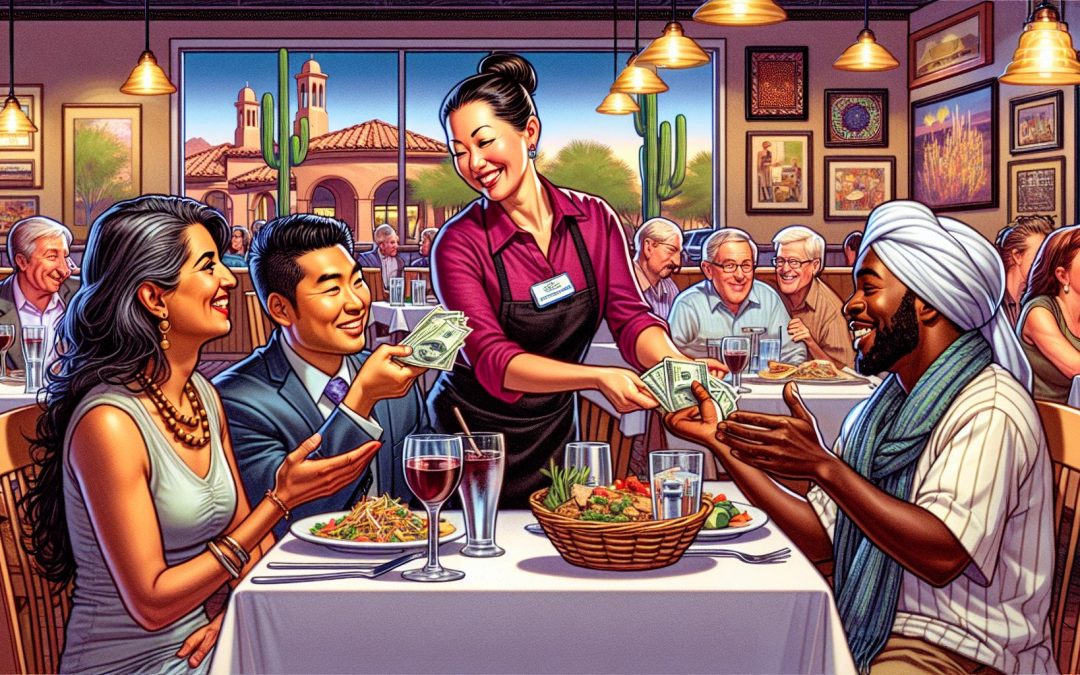Diving into Scottsdale’s vibrant dining scene, I’ve noticed something that stands out: the tipping culture. It’s a fascinating aspect that can sometimes feel like navigating a maze, especially for newcomers or tourists. Understanding the norms and expectations around tipping in Scottsdale restaurants is not just about etiquette; it’s about appreciating the people who make our dining experiences memorable.
From chic cafes to upscale eateries, the question of “how much should I tip?” is ever-present. I’ve learned that tipping here isn’t just a gesture of gratitude; it’s deeply ingrained in the service industry’s fabric. It reflects the appreciation for the hard work and dedication of those serving us. Let’s peel back the layers and delve into what makes tipping in Scottsdale’s restaurants a unique part of the dining experience.
Origins of Tipping Culture in Scottsdale
When I first ventured into Scottsdale’s bustling restaurant scene, I found myself curious about the roots of its pronounced tipping culture. It’s fascinating to delve into history to understand how tipping, a practice that might seem straightforward to locals, holds deeper connotations in this vibrant city.
Tipping in Scottsdale, as I discovered, isn’t merely a transactional gesture; it’s steeped in tradition. The origins of tipping in Scottsdale trace back to the early days when the city began to emerge as a tourism and hospitality hub. The influx of tourists, attracted by the city’s stunning landscapes and luxurious resorts, led to the blossoming of a service-oriented economy. Workers in these sectors often relied on tips to supplement their income, given the fluctuating nature of tourism.
What’s particularly interesting about tipping culture in Scottsdale is how it evolved alongside the city’s growth. As Scottsdale transformed from a quiet desert town into a thriving urban center, the expectations around tipping grew. Servers, bartenders, and even hotel staff came to see tips as not just a bonus but as a critical part of their earnings. This expectation is mirrored in the patron’s understanding of tipping as an acknowledgment of high-quality service and a direct way to support those who make Scottsdale’s dining and hospitality experiences memorable.
As I explored this topic, I was struck by stories from local service workers. They shared how tipping has facilitated a unique bond between them and the patrons. This connection transcends mere financial transactions and is about recognizing the effort and dedication behind the scenes.
In Scottsdale, tipping is more than a gesture; it’s a celebration of the hard work that goes into ensuring every visitor’s experience is nothing short of spectacular. It reflects an understanding and appreciation that, while may have adapted over time, continues to be a pivotal element of the local dining and hospitality industry.
Factors Influencing Tipping Norms

In exploring the tipping culture in Scottsdale, I’ve come to realize that several factors play a significant role in shaping the norms around tipping at restaurants. These aren’t just whims of the moment but are deeply embedded in the fabric of the city’s dining scene.
First and foremost, the quality of service stands out as a pivotal factor. It’s no secret that exceptional service prompts me to tip generously. There’s something about a server remembering your drink order or bringing out your meal just the way you like it that makes the experience worth every penny. It’s their attentiveness and effort that elevate the dining experience, making it memorable.
Then, there’s the restaurant’s ambiance and prestige. I’ve noticed that the more upscale a restaurant, the higher the expectation to tip well. It’s as though the immersive experience, from the meticulously designed interiors to the exquisite presentation of the food, sets the stage for higher tipping. Dining at these places isn’t just about the meal; it’s about the entire experience, and that’s reflected in the tips.
Interestingly, social norms and peer pressure also play a considerable role. When I’m out dining with friends or business associates in Scottsdale, there’s an unspoken expectation to match or exceed the tipping standards set by the group. No one wants to be seen as stingy, especially in a city known for its hospitality.
Here’s a quick summary of the key factors:
- Quality of Service
- Restaurant’s Ambiance and Prestige
- Social Norms and Peer Pressure
Tipping, in Scottsdale, goes beyond the transactional. It’s a recognition of the hard work, dedication, and artistry of those who make our dining experiences truly special. Each factor, from the smile of a welcoming host to the ambiance that transports you to another world, influences how we tip. And as the city continues to thrive and evolve, so too does its tipping culture, adapting and responding to the new trends and expectations of both patrons and service workers.
Typical Tipping Percentages in Scottsdale
When I’m dining out in Scottsdale, one thing I always keep in mind is tipping etiquette. It’s not just about showing appreciation for good service; it’s also about understanding and respecting the local norms. Over the years, I’ve noticed that the standard tipping percentages in Scottsdale usually fall within a specific range, reflecting both the quality of service and the local dining culture. To give you an idea, here’s a quick breakdown of what’s typically expected:
| Service Quality | Tipping Percentage |
|---|---|
| Basic | 15% |
| Good | 18% |
| Exceptional | 20% or more |
For basic service, where the server does what’s expected but maybe doesn’t go above and beyond, a 15% tip is pretty standard. It says “thanks” without being over the top. But when service is good — when a server is attentive, friendly, and maybe gives a few recommendations that hit the mark — bumping that up to 18% shows my appreciation for their effort. And then there’s exceptional service. You know it when you see it. The server not only meets your needs but anticipates them, making the whole dining experience something special. In those cases, I’m happy to leave 20% or more.
But there’s more to tipping in Scottsdale than just considering the percentage. Other factors often come into play. For instance, if I’m dining in a high-end restaurant where the ambiance adds significantly to the experience, I might lean towards the higher end of the tipping scale, regardless of whether the service was good or exceptional. Similarly, during busy holiday seasons or events, recognizing the extra pressure on the staff with a more generous tip feels right to me.
In essence, tipping in Scottsdale isn’t a one-size-fits-all approach. It’s about reading the room, understanding the level of service, and showing appreciation accordingly.
Navigating Tipping in Different Restaurant Settings
In Scottsdale, just like any other place, the setting of the restaurant plays a crucial role in how I approach tipping. Let me walk you through some insights I’ve gained from my experience dining in various settings across the city.
Casual Dining spots are where I usually find a relaxed atmosphere, with a significant focus on comfort and efficiency. Here, the staff often juggles multiple tables, ensuring everyone’s needs are met promptly. Given their hard work, I lean towards the higher end of the tipping scale, around 18% to 20%, especially if the service impresses me.
When I step into a Fine Dining establishment, the ambiance shifts dramatically. The attention to detail, from the presentation of food to the personalized service, is evident. Servers in these venues not only serve food but also enhance the dining experience with their knowledge and attentiveness. Hence, for such exceptional service, tipping beyond 20% feels not just appropriate but necessary to me.
Buffet Settings offer a different dilemma. Since I’m usually serving myself, it might seem logical to tip less. However, there’s still staff who clear plates, refill drinks, and ensure the buffet line is impeccably maintained. In these situations, I find a tip of 10% to 15% to be a fair reflection of my appreciation for their behind-the-scenes effort.
Dining at Quick Service or Fast Casual restaurants, I’ve noticed a trend towards tip jars at the counter or tipping options on payment tablets. Even though the service style is more hands-off, these workers often go above and beyond to ensure cleanliness and offer help with orders. I typically leave a 10% tip, acknowledging their effort in making my dining experience pleasant.
In all scenarios, remembering that everyone behind the restaurant experience contributes to my enjoyment makes tipping more than just a transaction; it’s my way of saying thank you.
Best Practices for Tipping in Scottsdale

When I’m dining out in Scottsdale, I’ve found that following a few best practices for tipping can really make a difference in showing appreciation for service staff. It’s not just about the amount; it’s also about understanding the context and making the process smooth for everyone involved.
Firstly, always check your bill before deciding on the tip. Some restaurants in Scottsdale include a service charge, especially for larger parties. This can range from 18% to 20%. If this charge is already added, you can still leave an extra amount if you feel the service was exceptional, but there’s no obligation.
For situations where service exceeds expectations or when dining at high-end restaurants, tipping above the standard 20% can be a kind gesture that acknowledges the extra effort put in by the staff. I’ve always believed that tipping generously, within reasonable bounds, reflects well not only on the diner but also enhances the overall dining ecosystem.
Remember, cash is king in the tipping world. While it’s perfectly acceptable to tip with your credit card, tipping in cash ensures that the full amount goes directly to the server or the team without any delays or deductions. Whenever feasible, I try to leave my tips in cash, particularly for smaller checks or when the service has been notably good.
Additionally, consider the full experience—from the hostess greeting you at the door to the quality of service at your table. Tipping isn’t just for the person who brings your food; it’s a recognition of everyone who contributes to making your dining experience pleasant. If there’s a way to tip a busser or a bartender directly for their part in your service, don’t hesitate to do so.
Here’s a quick reference on standard tipping rates based on the dining setting:
| Dining Setting | Suggested Tip Percentage |
|---|---|
| Casual Dining | 15% – 20% |
| Fine Dining | 20% – 25% |
| Buffet | 10% – 15% |
| Quick Service | No tip required |
By keeping these best practices in mind, I’ve found that not only do I ensure fair compensation for the servers, but I also contribute to a culture of respect and appreciation within the Scottsdale dining scene.
Conclusion
Navigating the tipping culture in Scottsdale’s vibrant restaurant scene doesn’t have to be daunting. I’ve found that a little knowledge and consideration go a long way in making sure I’m part of fostering a respectful and appreciative dining environment. Remembering to check for service charges, tipping in cash when possible, and adjusting my gratuity based on the quality of service ensures I’m doing my part. It’s all about recognizing the hard work behind our dining experiences. So next time you’re out enjoying Scottsdale’s culinary delights, keep these tips in mind. It’s a simple way to show gratitude and ensure the tradition of tipping continues to benefit those who make our meals memorable.







